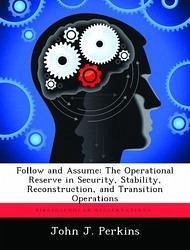Due to the current size of the U.S. Army and operational tempo, the Army National Guard and Army Reserve have been moved from a strategic reserve to an operational reserve. This thesis attempts to answer the following question: What is the best use of the operational reserve in Security, Stability, Reconstruction, and Transition (SSRT) and Counterinsurgency (COIN) operations. To arrive at this answer, selected historical case studies are used to gain insight into the best practices for SSRT and COIN. Several themes stand out. These include the primacy establishing and maintaining a secure environment, the historic failure of the Army to sufficiently plan for the transition from combat to SSRT operations, the commonality between SSRT and COIN, and lack of planned capability for SSRT and COIN skill sets in either the Active or Reserve component. This study further looks at how the Operational Reserve can be used to address these shortcomings. In conclusion, several recommendations are made on missions and focus for the Operational Reserve in order to support Army full-spectrum operations.
Hinweis: Dieser Artikel kann nur an eine deutsche Lieferadresse ausgeliefert werden.
Hinweis: Dieser Artikel kann nur an eine deutsche Lieferadresse ausgeliefert werden.








